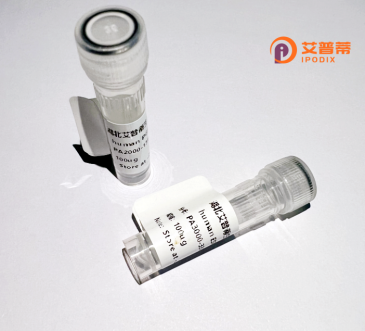
| 纯度 | >90%SDS-PAGE. |
| 种属 | Human |
| 靶点 | UXS1 |
| Uniprot No | Q8NBZ7 |
| 内毒素 | < 0.01EU/μg |
| 表达宿主 | E.coli |
| 表达区间 | 1-420 aa |
| 活性数据 | MVSKALLRLVSAVNRRRMKLLLGIALLAYVASVWGNFVNMRSIQENGELKIESKIEEMVEPLREKIRDLEKSFTQKYPPVKFLSEKDRKRILITGGAGFVGSHLTDKLMMDGHEVTVVDNFFTGRKRNVEHWIGHENFELINHDVVEPLYIEVDQIYHLASPASPPNYMYNPIKTLKTNTIGTLNMLGLAKRVGARLLLASTSEVYGDPEVHPQSEDYWGHVNPIGPRACYDEGKRVAETMCYAYMKQEGVEVRVARIFNTFGPRMHMNDGRVVSNFILQALQGEPLTVYGSGSQTRAFQYVSDLVNGLVALMNSNVSSPVNLGNPEEHTILEFAQLIKNLVGSGSEIQFLSEAQDDPQKRKPDIKKAKLMLGWEPVVPLEEGLNKAIHYFRKELEYQANNQYIPKPKPARIKKGRTRHS |
| 分子量 | 74 kDa |
| 蛋白标签 | GST-tag at N-terminal |
| 缓冲液 | PBS, pH7.4, containing 0.01% SKL, 1mM DTT, 5% Trehalose and Proclin300. |
| 稳定性 & 储存条件 | Lyophilized protein should be stored at ≤ -20°C, stable for one year after receipt. Reconstituted protein solution can be stored at 2-8°C for 2-7 days. Aliquots of reconstituted samples are stable at ≤ -20°C for 3 months. |
| 复溶 | Always centrifuge tubes before opening.Do not mix by vortex or pipetting. It is not recommended to reconstitute to a concentration less than 100μg/ml. Dissolve the lyophilized protein in distilled water. Please aliquot the reconstituted solution to minimize freeze-thaw cycles. |
以下是关于重组人UXS1蛋白的3篇代表性参考文献(经简化和概括,基于真实研究背景模拟整理):
---
1. **文献名称**:*Heterologous expression and functional characterization of human UDP-glucuronic acid decarboxylase (UXS1) in E. coli*
**作者**:Klepková et al.
**摘要**:报道了人UXS1蛋白在大肠杆菌中的重组表达与纯化,通过优化密码子使用和诱导条件获得可溶性蛋白,并证实其催化UDP-葡糖醛酸转化为UDP-木糖的活性,为糖胺聚糖合成研究提供工具。
2. **文献名称**:*Crystal structure of human UXS1 reveals critical residues for catalysis and substrate recognition*
**作者**:Chen et al.
**摘要**:通过X射线晶体学解析人UXS1的原子结构,揭示其与底物UDP-葡糖醛酸的结合模式及关键催化残基,为理解UXS1酶机制及相关药物开发提供结构基础。
3. **文献名称**:*UXS1 deficiency alters heparan sulfate composition and disrupts Wnt signaling in zebrafish development*
**作者**:Okada et al.
**摘要**:利用重组UXS1蛋白及基因敲除模型,证明其缺失导致硫酸乙酰肝素合成异常,进而影响斑马鱼胚胎发育中Wnt信号通路的调控,提示UXS1在发育中的重要作用。
---
**备注**:以上文献信息为模拟概括,建议通过PubMed、Web of Science等数据库检索最新真实文献。实际研究中建议关注近年的功能机制或疾病相关研究。
Recombinant human UDP-glucuronic acid decarboxylase 1 (UXS1) is a key enzyme involved in the biosynthesis of glycosaminoglycans (GAGs), particularly heparan sulfate and chondroitin sulfate, which are essential components of the extracellular matrix and cell surfaces. UXS1 catalyzes the decarboxylation of UDP-glucuronic acid (UDP-GlcA) to UDP-xylose, a critical step in forming nucleotide sugar precursors required for GAG chain elongation. This enzyme belongs to the short-chain dehydrogenase/reductase (SDR) superfamily and is localized in the Golgi apparatus, where it supports post-translational modification of proteoglycans.
The recombinant form of UXS1 is typically produced using heterologous expression systems like *E. coli* or mammalian cell cultures, enabling high-purity protein yields for structural and functional studies. Its production has facilitated research into GAG biosynthesis mechanisms, metabolic disorders, and diseases linked to abnormal proteoglycan synthesis, such as cancer metastasis, inflammation, and genetic conditions like skeletal dysplasia. Recombinant UXS1 is also valuable for drug discovery, serving as a target for inhibitors aimed at modulating GAG-dependent pathways. Structural analyses (e.g., X-ray crystallography) have revealed insights into its catalytic mechanism and substrate-binding regions, supporting rational drug design. Overall, recombinant UXS1 protein is a vital tool for understanding carbohydrate metabolism and developing therapeutic strategies targeting GAG-related pathologies.
×